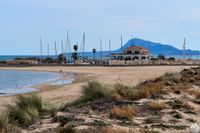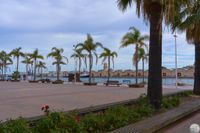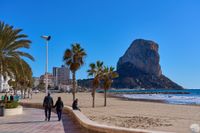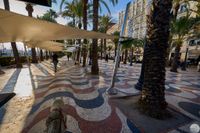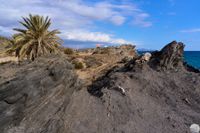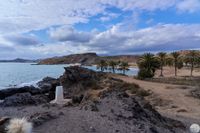Overwinter in Spain
Who doesn't know this: Summer is coming to an end, and from November at the latest, the dark, cold and wet season begins. There is a long time to bridge until next summer comes. Milestones like Helloween, Christmas, New Year's Eve, Carnival and Easter may lift the mood for a brief moment, but they cannot satisfy the longing for summer conditions.
For years we have had the opportunity to use the calendar low point to take a break from all the gray stuff. So we go to Spain's east coast for a few weeks around the turn of the year to recharge our batteries with the beautiful weather.
While life here is pulsating in summer, things are much more relaxed in winter.
We drive about 1800 km to the Costa Blanca and stay mainly in the region between Valencia and Alicante. The weather here is mostly sunny with 15°C to 25°C during the day. Particularly pleasant: While at home the sun sets on the horizon around 4:30 p.m., here we enjoy it in the sky until around 6:00 p.m.
Oliva
Our central contact point is south of Oliva on the Eurocamping. The complex is located directly on the fine sandy beach of Platja Rabdells and, in addition to very friendly staff, offers a very pleasant infrastructure. There are several sanitary buildings, a supermarket and a restaurant on the square. The range of pitches is varied, with some shaded by trees as well as dune pitches directly on the beach. But small wooden huts are also available for rent as residential units.
The beach is wide and fine sand. Both north and south we can walk for hours and kilometers and enjoy the sea. The dogs also get their fun, as there is enough space to run around and play here.
We walk along the beach north to Oliva. Behind the dunes on the left side there are alternating orange plantations and wild growth before the first buildings in the city appear.
It doesn't take long until we are at the port of Oliva. There is also another well-known camping facility here, the Kikopark, which is well attended. From the dune we have a beautiful view north to Gandia and south across the harbor to Denia.
Parc Natural de la Marjal de Pego-Oliva
The Riu del Vedat river flows into the sea south of the Eurocamping. We follow this riverbed a few kilometers inland and reach the Font Salada behind the motorway underpass. A water spring at around 25°C, which is ideal for swimming in the open air even in winter, while the adjoining restaurant offers gastronomic delicacies.
We continue into the natural park behind, a swamp area that is obviously fed by the Riu del Vedat. At this time of year we are impressed by the many tall reed plantations, where wooden walkways provide access and allow us to observe the flora and fauna from up close.
We continue walking around the Mirador de la Muntanyeta Verda, a viewing platform on a hill here in the area. We enjoy the peace and quiet on the one hand and the gentle sounds of the wildlife and the reeds in the wind on the other, largely undisturbed: only occasionally do we meet other passers-by who are enthusiastically marveling at this park.
On the southern side of the viewing platform are local rice plantations, the cultivation of which is one of the local specialties. You can buy local rice in various delicatessen shops here. It differs from the otherwise well-known long grain rice and is often used as a basis for preparing Spanish paella.
Gandia
About 20km further north from Eurocamping we reach Gandia and park at the harbor, the Port de Gandia. Around the harbor we first aim for the land bridge, which on the one hand offers protection to the harbor and on the other hand is within walking distance to the sea and offers great views from the Faro del Grau de Gandia viewing platform.
So we are amazed at the panorama to the north of the promenade of Gandia and the town of Cullera behind it, inland to the harbor and south to the coastal strip to Oliva and beyond.
We want to continue towards the promenade. While small boutiques, restaurants and hotels line up unobtrusively on the left, we see the very beautiful, fine sandy beach on the right. Typical beach sports are supported here with existing equipment and are freely accessible. The Mediterranean atmosphere is underlined by the palm trees planted everywhere.
Denia
We reach Denia around 21km south of Eurocamping, and here we park again at the harbor. In addition to fishing boats, yachts of various sizes and a ferry line that connects from here to the Balearic Islands dominate here. We look into the city and see the Castell de Denia on a hill, a fortress with a contrasting effect on the surrounding buildings.
We marvel at the hustle and bustle here before we stroll on to the Carrer del Marques de Campo pedestrian passage. We find many small boutiques and restaurants here, surrounded by large stands of trees. At the end of the passage, a small park-like island appears in the roundabout, where we turn right into the pedestrian passage Carrer del Cop. At the end of this passage we see the town hall and the Church "de l'Assumpcio" of Denia on the right.
Barely 5km further south from the harbor car park we reach a small parking bay at Cala Les Rotes, a rocky bay from which a hiking trail leads along the cliff area to Cova Tallada. Impressive rock caves where the surf has formed.
On the way there we pass Mirador Las Rotas, a viewing platform with a view over the coast from a hill. For enthusiastic climbers, a steep path later leads further up into the barren wilderness with small trails, which also reveal larger hiking routes to choose from, including to Cap Sant Antoni.
Granadella
We continue on small mountain roads for a good 21km, first towards Javea and from there towards Cap Marti, Cabo de la Nao to the Cala Granadella car park. Passing interesting properties in the middle of the Mediterranean wilderness, we reach this bay, which is picturesquely decorated with few buildings and surrounds itself with steep rocky slopes at the foot of the bay.
The small, coarse, white beach invites you to linger. Beautifully rugged cliffs amaze us from any position. In the clean, clear water we observe smaller schools of fish that obviously have their home here. A nice background noise, as the surf is amplified on the one hand when it hits the coarse gravel and on the other hand by the steep rocky bay. A small restaurant invites you to linger and enjoy, located right at the end of the street.
A small and sometimes challenging hiking trail leads not far from the parking lot along the cliffs to the Castell de la Granadella, the remains of a historical attraction, from which there are further great views over the cliffs in all directions. The path continues in a southerly direction ascending to the Mirador de Llevant, partly along narrow paths on the ridge. We look over to the Cumbre del Sol urbanization, a complex in the distance on another towering mountainside. We can choose a little later: left towards the urbanization or right back to the starting point in Granadella.
Calpe
From Eurocamping we drive around 50km south and reach the former fishing town of Calpe, which has developed significantly in terms of tourism in the last few decades. While there are numerous urbanizations in the hinterland, we find numerous high-rise buildings in the city itself, right up to the two beach promenades, which significantly affect the landscape. The dense development suggests that a high density of tourism can be expected here in the high season. However, we don't see much of it in winter.
The city's landmark is the Peñon de Ifach, a 332m high rock massif that juts out into the sea. Meanwhile, designated as a nature park, hiking trails lead up to the top of the mountain. The peace and quiet up here, the incredible views of the Sierra Aitana and the sound of seagulls reward the demanding climb, which should take around two and a half hours. Particularly exciting: a tunnel separates the path from two different views and makes the climb even more exciting. The approximately 30m long tunnel was dug in 1918 and is now partly as smooth as glass. Ropes at the side of the path are a good idea to avoid losing your footing. At the other end of the tunnel there is an incredible silence away from the calls of seagulls in the protection of the mountain range and the surrounding rocky plants.
At the foot of the Peñon de Ifach lie the Salinas of Calpe, which were once used to produce sea salt. Today there is a park around it and flamingos have made their home in the Salinas. It's worth taking a walk to get a closer look at these birds.
The promenade north of the Ifach is located on the Platja de la Fossa, a slightly sheltered bay with hotels, boutiques and restaurants of all kinds. The southern promenade connects directly behind the harbor to the Platja de Cantal Roig and appears a little more open. Here too we find a selection of hotels, boutiques and restaurants, and look out to the distant rocky outcrop with the Parc Natural de la Serra Gelada behind Altea.
Alicante
About 103km south of Eurocamping we reach the city of Alicante, which has around 331,000 inhabitants. It is located directly on the coast and its center is directly at the harbor. To the north of the city, the Castell Santa Barbara sits on a hill. We find a parking space on Carrer Dona Violante and first walk to the harbor. This is also where the Passeig de l'Esplanada d'Espanya, Alicante's promenade, is located, which is one of the city's landmarks. Strolling over it is a real experience. Surrounded by the harbor on the one hand and the impressive buildings on the other, the large palm gardens and rustic rubber trees make for a varied walk. Small cafes along the way invite you to linger and take a break.
As you move into the city, the traffic density and shopping opportunities increase, including the country's well-known large department stores. We only take a short walk and choose the path back along the harbor and visit the Castell Santa Barbara, which has been considered a cultural asset since 1961. The footpath runs away from the city through the "Parc de l'Ereta" park up to 166m, where the castle allows exciting 360° panoramic views of the entire area and beyond. It also offers exciting indoor exhibitions, gastronomic treats and a souvenir shop. We need a good 2 hours up here to look around and enjoy the views.
Playa de Percheles
We heard a lot about Snake Bay and Goat Meadow. We'll take a look for ourselves and take a look around. Playa de Percheles is 252km away from Eurocamping near Oliva in a southerly direction behind Mazarrón. The bay is away from major civilization. We don't spend the night here ourselves, although there are a few campers here.
The area known as goat meadow also seems less interesting to us. Things look different with the Snake Bay behind it, as Playa de Percheles is also called. As we walk we enjoy the rugged solitude and the beautiful palm-lined beach bay from above. We see a larger area directly on the beach, which is closed at the time of our visit. In the surrounding area we meet some wild campers with their vehicles who are obviously attracted to the lonely and beautiful location.
We decide to remember this place in the largely quiet state we found and very much hope that this place will remain as untouched in the future.















